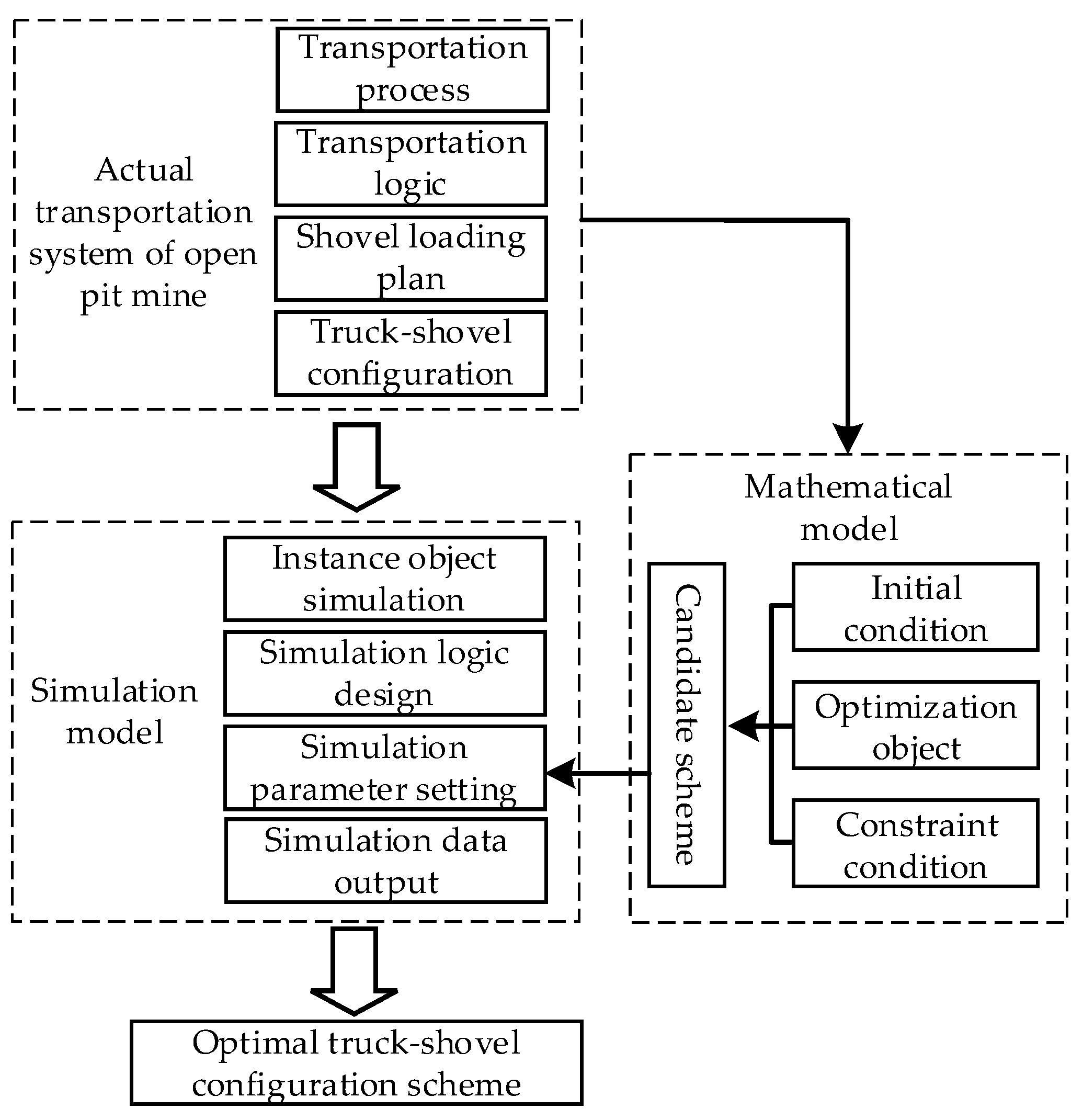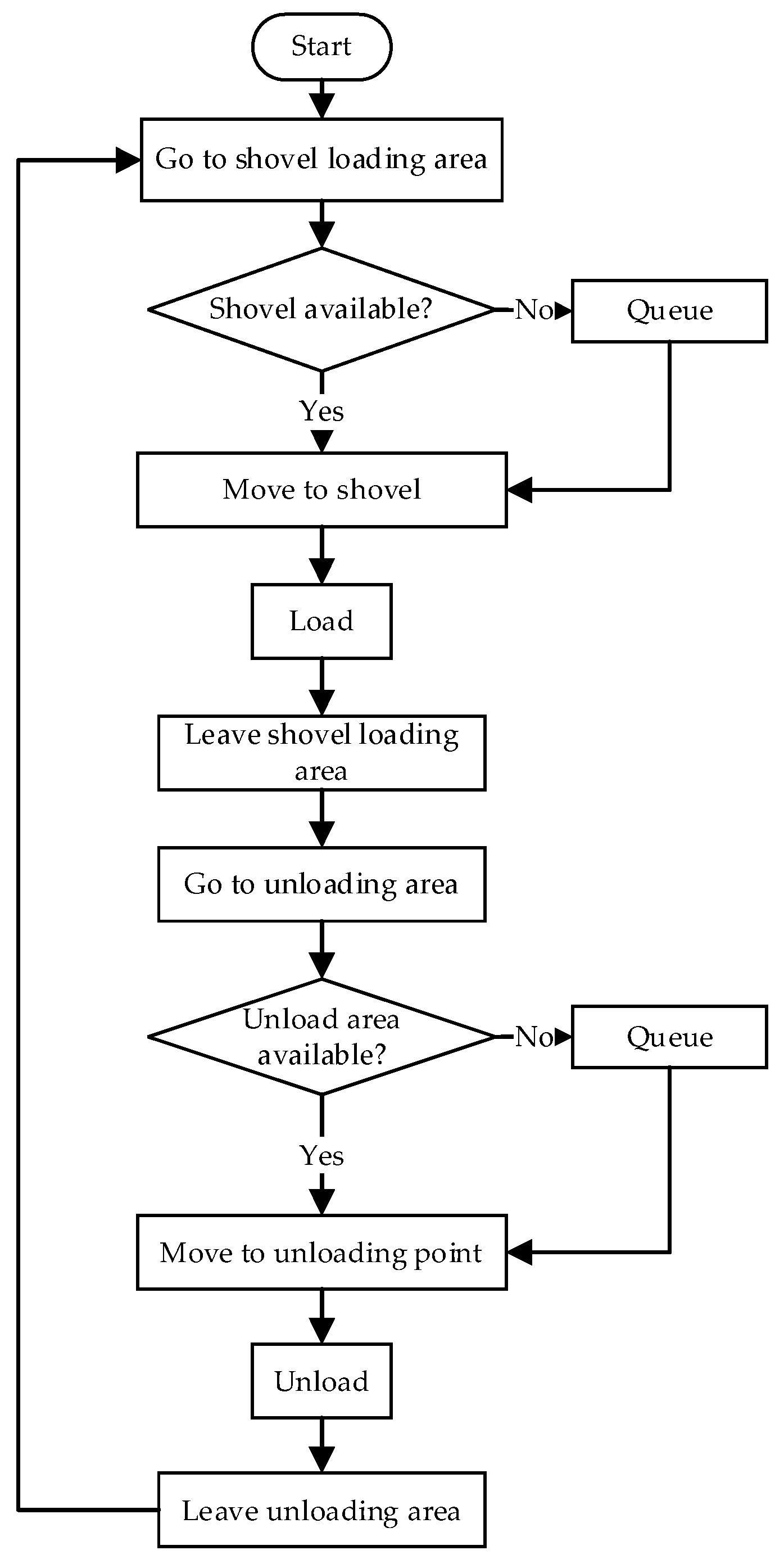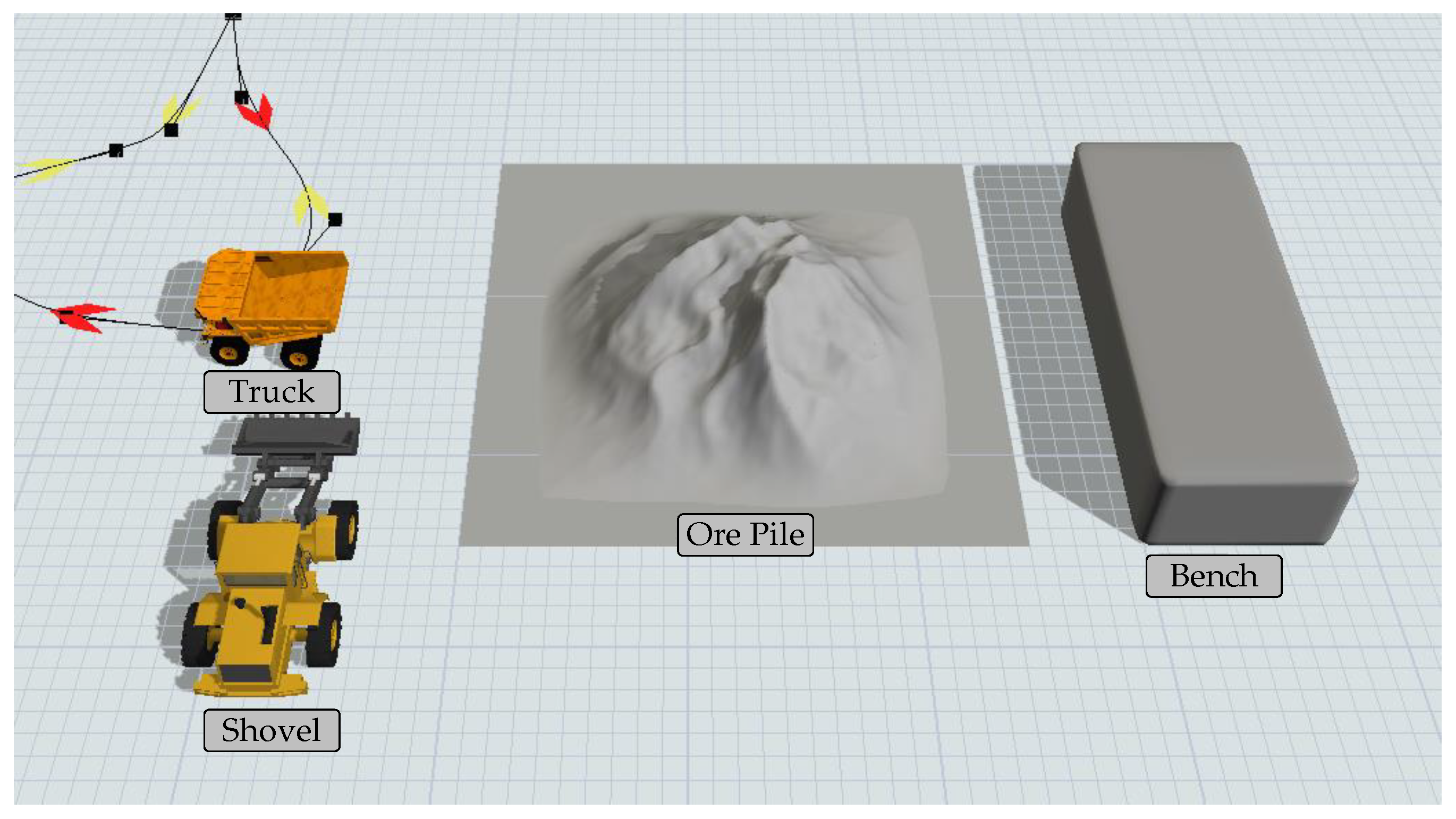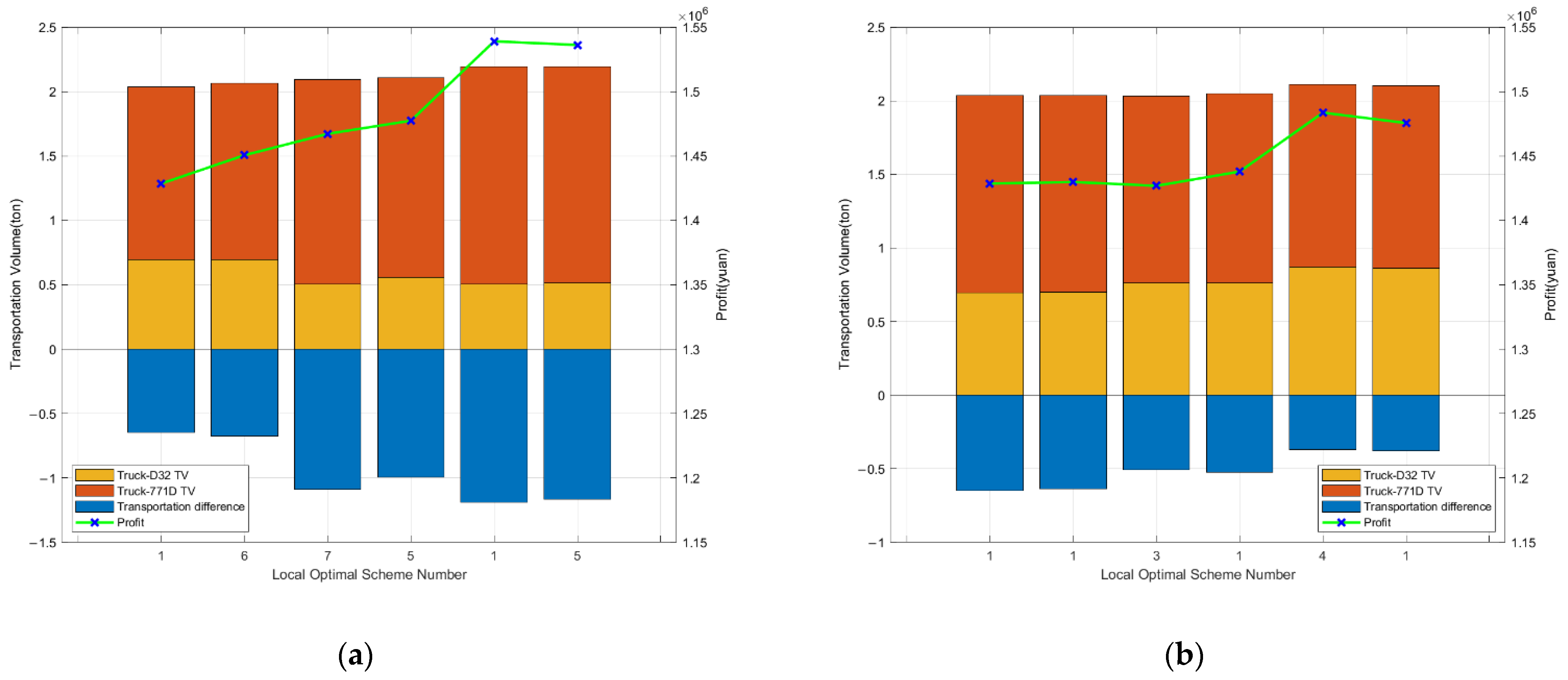3.1. Overview of Simulation Model Construction
When evaluating or optimizing the current mine truck–shovel system in the simulation environment, there are two difficulties in constructing the simulation model: one is whether the accuracy of the established model can meet the requirements of the simulation experiment; the second is whether the relevant logic of the model can truly reflect the operation of the real system, such as the problem of truck speed control, the queuing strategy of trucks in the loading and unloading area, whether trucks are allowed to overtake, etc. Only the above two points satisfy the requirements; the simulation model can represent the real situation as much as possible and its simulation results can have guiding significance and value.
During the process of constructing the simulation model of the open-pit mine truck–shovel system and realizing the optimization purpose, on the one hand, the random variable parameters of the system should be determined, on the other hand, the system logic should be designed and secondarily developed. Considering the uncertainties of the real truck–shovel system, such as the loading and unloading time of the truck, the running speed of the truck and many other parameters that are in dynamic changes, we designed and developed the system behaviors in Flexsim in order to realize the simulation of the uncertainty in the transportation processes of an open-pit mine.
After completing the overall layout construction of the truck–shovel system model and clarifying the operation process of the simulation system, it is also necessary to set up the submodules and their basic objects and to use the object attributes and the interaction logic between objects to realize the main functions of the four submodules of the shovel-loading area, unloading area, transportation route and dispatching center in the system.
Finally, in addition to the macro model, it is also necessary to consider the micro impact of the system. By inputting the actual data into the model, we can verify the simulation model and further adjust the model to reduce the overall impact of some unconstrained micro variables in the system; collect and analyze the production data of loading and unloading time, bucket capacity, single loading capacity, average speed, etc., of trucks and shovels in a mine; apply the data in the simulation model and compare the output with the daily production results of the mine; test whether the parameters in the system are reasonable and whether the correlation between the operation logic and the system efficiency is correct in order to build a simulation model of the open-pit mine truck–shovel system that conforms to the realistic logic with reasonable errors. Based on this model, the candidate truck–shovel allocation scheme obtained from the mathematical model in
Section 2 can be tested to determine the best allocation scheme.
3.2. Specific Construction Process in Flexsim
To build the simulation model of the truck–shovel system in Flexsim and to model each submodule with its entity objects, it is necessary to establish the communication and interaction logic between entity objects with the help of Flexsim functions such as
Port Connection,
Labels,
Triggers and
Temporary Entity Flow, and finally realize the stable operation of the simulation system. Among them, port connection establishes the connection between entities, realizes the communication between entities and transmits temporary entity items. Labels store entity information and are often used for reference of entity attributes and logic, condition decision making and real-time tracking of attribute information in programming. Trigger refers to when events related to entities occur in the simulation system, the corresponding trigger executes relevant logic, resulting in the occurrence of other behaviors or events. Temporary entity flow controls the entry and exit mode of temporary entities and determines upstream and downstream entities. In addition, other basic attributes of the entity object in Flexsim are also used to realize the basic attributes and functions of the corresponding entity of the truck–shovel system. The logic of the submodule construction of the shovel-loading area is shown in
Figure 4.
- (1)
Construction of shovel-loading area
The shovel-loading area is used to simulate the generation of ore piles and materials and the process of the shovel-loading link, mainly including working faces, blasting piles, shovel-loading equipment and unloaded trucks. In the Flexsim entity library,
Source,
Queue,
Processor and
Task Executor entities are applied to simulate the above objects and to implement their functions. The specific operation process of the shovel-loading area is as follows: after the mineral materials are produced on the working face, the materials are temporarily stored in the blasting pile, then the shovel transfers them to the truck.
Figure 4 shows the logic of the submodule construction of the shovel-loading area, including mine entity, the corresponding Flexsim entity and the function realization.
The main function of Queue is to temporarily store the materials to be loaded, which simulates the blasting pile generated after the blasting operation. Item simulation mainly sets the Source (working face), Arrival Schedule and On Creation, and parametrically defines the physical properties, generation time, type, quantity, grade, etc., of materials. By setting the rules of last in/first out (LIFO), late arriving materials can be processed first. By setting the temporary entity Flow, the downstream entity of the material, namely the output port, is controlled, which is generally the shovel in the current shovel-loading area. Triggers include three functions: entry, message and reset. It is mainly used to record properties such as type, processing time and transportation volume of materials in the stack segment.
Processor simulates the shovel to transfer the blasting materials onto the transport truck. The Labels of shovels mainly include “Size”, “DipperCapacity”, “CurrentState”, “ProcessTime”, “TotalOreItemWeight”, “CurrentTruck”, etc., which respectively record the attributes of shovel size and bucket capacity, track the real-time state of shovel, record the running time of the shovel, record the quality of materials loaded by the shovel and display the trucks currently performing loading tasks at this shovel. The shovel connects the upstream and downstream entities of the material through Input Ports and Output Ports, i.e., the blasting pile and the unloading point, to determine the source and destination of the material. The shovel is connected to the Dispatcher and the Network Node through the central port. When the shovel finishes handling materials, it generates a transportation task sequence. After obtaining the task sequence, the Dispatcher sends it to the designated or available truck, and the truck goes to this shovel to implement the loading task. Set the material handling time and loading animation of the shovel by setting the Processing Time, On Reset trigger, entry trigger, exit trigger and message trigger and record the quantity and quality of materials handled by the shovel, as well as the number of collaborative transportation trucks.
Task Executor simulates the transportation truck, which is the most important entity object in the truck–shovel system. It runs in the loading and unloading area and on the transportation line to complete the loading, transportation and unloading of materials. In the shovel-loading area, it mainly interacts with the shovel to execute the shovel-loading task sequence. The main attributes of the trucks include capacity, max speed, acceleration, deceleration, rotation threshold, load time, unload time, queue strategy, etc. The labels of trucks mainly include “MaxSpeed”, “LoadCapacity”, “TotalTravel”, “CurrentState”, “LoadTime”, “UnloadedTime”, “BlockTime”, “TotalOreItemWeight”, “CurrentLocation”, etc. These truck labels respectively set the maximum speed and load capacity, record the total distance, track the real-time status, set the loading and unloading time, queue time, record the total mass of materials and track and display the real-time location, etc. Through the above multi-type triggers, the attributes of trucks can be set and recorded and the simulation of the truck operation process can be realized.
The 3D model of a shovel-loading area built in Flexsim is shown in
Figure 5.
- (2)
Construction of unloading area
The unloading area is used to simulate unloading, belt transportation, storage and other functions of materials, mainly including unloading points, heavy loading trucks, conveyor belts and other entities. In the Flexsim entity library, the above objects are simulated with Queue, Task Executor, Conveyor, Sink and other functions.
Figure 6 shows the logic of the submodule construction of the unloading area. We use the unloading point to receive the materials unloaded by the truck and to store them. It can be connected to multiple input ports, which means that the materials from multiple shovel-loading areas can be transported to this unloading point for unloading. When there is an ore blending demand, the ore blending function can be realized by setting attributes such as the material unloading ratio. The materials unloaded at the unloading point will be transported to the downstream beneficiation plant by belt and the simulation will be realized by applying the
Conveyor object and the
Sink object in Flexsim.
The 3D model of an unloading area built in Flexsim is shown in
Figure 7.
- (3)
Design of transportation route
The transportation route submodule is an important module for transferring materials. It provides the driving route for the transportation truck and simulates the driving situation of the truck on the real road, mainly including the transportation route and the truck performing transportation tasks. In the Flexsim entity library, we use Network Node and Task Executor entities to simulate the above objects, respectively.
Figure 8 shows the logic of the submodule construction of the transportation route. According to the original geological data of the mine, the three-dimensional node information is established and the node connection forms routes. Since the node is three-dimensional, the route naturally has a slope attribute. The more the node information is established, the more accurately the transportation route is constructed. The transportation route is deployed in the simulation environment. After the truck connects with its port and establishes an interactive relationship, it will drive between the loading and the unloading areas according to the transportation path to complete the material transportation task. We set the transportation route attributes through transportation route nodes, including the maximum number of passing devices, overtaking rules, truck safety distance, speed limit, queuing strategy, etc.
The 3D model of the transportation route built in Flexsim is shown in
Figure 9.
- (4)
Design of dispatching center
The main function of the dispatching center submodule is to generate a command sequence for the truck according to the shovel task sequence and to simulate the truck dispatching function; the construction process is shown in
Figure 10. The dispatching center realizes interactive communication by connecting with the shovel to judge whether the shovel currently has a task sequence. When there is a task sequence, it turns it into a command sequence and sends it to the designated or available truck. Then, the truck performs specific tasks according to the command sequence.
The 3D model of the dispatching center is shown in
Figure 11.
- (5)
Design of equipment parameter
In the open-pit mine truck–shovel simulation system, the relevant equipment parameters have a significant impact on the system operation efficiency. The main parameters are truck speed, loading time, unloading time, single transportation quality, etc. Among them, the truck speed is usually related to the truck’s own attributes, transportation route characteristics, mining equipment operation requirements, etc. In addition, there are speed limits when the truck is in the shovel-loading area, unloading area, intersection and uphill or downhill. In the simulation model, the average speed of the truck is set by the maximum speed, which means that the truck starts driving at a constant speed when it reaches the maximum speed. The value of this parameter is determined according to the actual situation of the mine. For random variables such as loading and unloading time, the distribution law can be determined by historical data collection and analysis of onsite trucks; the same probability distribution function can be used to assign values to them in Flexsim. After the data statistics and analysis of the loading and unloading time of a truck in a cement mine in Jiangsu Province, the results satisfy the normal distribution law, so the standard normal distribution will be applied in this example to assign values to the loading and unloading time of trucks.
- (6)
Example simulation model
For the purpose of verifying the reliability of the method and for obtaining the optimization scheme through experiments, we built a simulation model based on the above modeling process according to the specific situation of a cement mine in Jiangsu, China. The simulation model of this open-pit mine truck–shovel system is shown in
Figure 12. The basic mining parameters of this mine are shown in
Table 2.






















